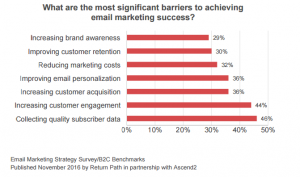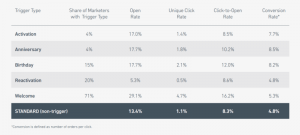
Sales-marketing alignment has seemingly been written about more than any other B2B marketing topic. (Well, maybe not as much as account-based marketing.)
We’ve certainly written our fair share on the subject. However, as much as previous sales-marketing-kumbaya content has served its purpose in the past, times are changing…and so must the ways in which this much-honored relationship works.
The lead gen era’s slow death: How it affects the marketing-sales relationship
Not too long ago demand marketing teams would generate leads, maybe nurture them a bit and then throw them over the wall to sales once they hit a status defined by agreed lead qualifications scores.
Forrester analyst Steven Wright summed up this concept very well in a recent brief:
“Until now, marketing’s role ended with ‘attract,’ which meant that the funnel metaphor and its companion waterfall determined the B2B marketer’s days and the handover to sales was clearly definable. But B2B buyers’ predilection for self-service is pulling marketing deeper into the sales process itself: Marketing and sales are now working almost in parallel along the buyer journey, which can cause tension and disconnects between the organizations. Instead of a discrete handover of leads and content between marketing and sales, the organizations must now exchange information on an ongoing basis.”
The buyer’s predilection for self-service (a result of the proliferation of digital touchpoints) has greatly affected the ways in which companies generate demand – for both good and bad. There’s obviously now many more ways to engage with prospects, which is great.
Yet, coordinating these engagements, organizing the resulting prospect data, measuring performance results, analyzing the info, providing follow-up content, adjusting campaigns, etc., has become an intricate maze that must be precisely coordinated and timed. This is why the topic of demand orchestration has become so important.
Moreover, such complexity doesn’t lend itself to a clear-cut set of rules stating when marketing should hand a lead over to sales. Instead, marketing and sales must work hand-in-hand through an expanding demand labyrinth, ensuring prospects get the attention and info they need at precisely the right cadence – from the top of the funnel to the bottom.

Today’s global demand centers: No longer “marketers only”
B2B marketing’s growing focus on account-based marketing (ABM) presents a great example of why marketing and sales must work closer than ever to achieve customer acquisition and revenue goals.
If sales isn’t involved in an ABM strategy from the start, that strategy will very likely fail. Think of the initial, fundamental steps required to launch an ABM program:
- Developing program goals (revenue and net-new accounts)
- Setting success metrics based on average contract value by company size, industry, etc.
- Identifying target accounts based on closed-won historical data
- Determining and aligning all the content used by both marketing and sales along the buyer’s path to purchase
None of these could happen without sales’ extensive input.

On the other hand, marketing must push its way into discussions regarding bottom-funnel efforts. It’s now critical that marketing understands all the nuances of how sales engages with account contacts, tracks its progress and where typical roadblocks may exist so that it can better assist sales with effective content.
Unfortunately, this isn’t a common practice. According to a recent B2B marketing survey, a mere 40% of marketers participate in sale’s pipeline reviews (Forrester’s Q2 2016 International B2B Marketing Strategies And Tactics Online Survey). How is marketing supposed to enable sales’ ABM efforts if it doesn’t understand what’s working and what’s not?
Steps to become annoyingly close to your sales colleagues
Only 30% of marketers claim to be aligned with sales metrics. And only half of marketers say they often collaborate with sales (Forrester’s Q2 2016 International B2B Marketing Strategies And Tactics Online Survey). Businesses that wish to scale efficiency in this evolving B2B marketing landscape must rethink their approach to this relationship.
Here’s some advice we’ve acquired from successful demand marketing departments over the last year:
1. Create an effective communication strategy with sales
Two tactics do a remarkable job in providing the required bi-directional communication:
- Regularly scheduled sales-marketing calls, and
- Periodically listening in to sales calls with prospects
Of course, larger organizations have more difficulty in executing these efforts. Yet, it’s not impossible, it just requires more discipline and a set agenda for each call. For example, requesting a selected number of sales reps and marketers to speak about predetermined topics during each call.
A sample weekly/monthly sales-marketing call agenda may include several or all of the following depending on time and size of organization:
A few items sales may want to cover:
- pipeline review and quarterly goals
- what’s working and what’s not
- customer/prospect feedback (maybe select a single rep per week to discuss recent experience)
- sales’ needs from marketing to hit goals (e.g., follow-up content, help with decks, RFPs, etc.)
- sales-tech initiatives
A few marketing discussion topics:
- events and other bulk lead-gen efforts that should affect pipeline
- messaging tweaks
- sales-enablement projects
- media coverage and ways sales may leverage it
- marketing-tech initiatives that’ll affect sales’ efforts (e.g., changes to lead nurturing and scoring)
2. Agree to joint sales-marketing KPIs throughout entire funnel
Marketing’s goals must be joined to sales’. And they must be measurable. Washing your hands clean of accountability after generating MQLs is no longer the way to thrive as a marketing organization.
Demand marketers should feel/be just as responsible for opportunities, closed-won accounts and revenue as the sales team. And sales must feel responsible for top-funnel performance metrics too, providing marketing with feedback to hone engagement initiatives. It’s amazing the extra effort both sides provide once they have skin in the larger game.
3. Don’t blame – focus on lessons learned
As Travis Goodrich, Enterprise Field Marketing at Amazon Web Services, once put it: “The relationship has to be one based on trust and complete transparency. Some stuff will work, other efforts won’t. You can’t have finger pointing or somebody on either team fear they’ll be fired when something doesn’t work. Rather, the culture has to focus on ‘What did we learn? and ‘How do we optimize it?’
This steps aren’t exhaustive by any means, but they should get your sales and marketing teams off to good start in redefining the nature of your relationship.
Business & Finance Articles on Business 2 Community
(95)
Report Post






